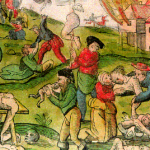 Technology
Technology  Technology
Technology  Humans
Humans 10 Everyday Human Behaviors That Are Actually Survival Instincts
 Animals
Animals 10 Animals That Humiliated and Harmed Historical Leaders
 History
History 10 Most Influential Protests in Modern History
 Creepy
Creepy 10 More Representations of Death from Myth, Legend, and Folktale
 Technology
Technology 10 Scientific Breakthroughs of 2025 That’ll Change Everything
 Our World
Our World 10 Ways Icelandic Culture Makes Other Countries Look Boring
 Misconceptions
Misconceptions 10 Common Misconceptions About the Victorian Era
 Mysteries
Mysteries 10 Strange Unexplained Mysteries of 2025
 Miscellaneous
Miscellaneous 10 of History’s Most Bell-Ringing Finishing Moves
 Technology
Technology Top 10 Everyday Tech Buzzwords That Hide a Darker Past
 Humans
Humans 10 Everyday Human Behaviors That Are Actually Survival Instincts
 Animals
Animals 10 Animals That Humiliated and Harmed Historical Leaders
Who's Behind Listverse?

Jamie Frater
Head Editor
Jamie founded Listverse due to an insatiable desire to share fascinating, obscure, and bizarre facts. He has been a guest speaker on numerous national radio and television stations and is a five time published author.
More About Us History
History 10 Most Influential Protests in Modern History
 Creepy
Creepy 10 More Representations of Death from Myth, Legend, and Folktale
 Technology
Technology 10 Scientific Breakthroughs of 2025 That’ll Change Everything
 Our World
Our World 10 Ways Icelandic Culture Makes Other Countries Look Boring
 Misconceptions
Misconceptions 10 Common Misconceptions About the Victorian Era
 Mysteries
Mysteries 10 Strange Unexplained Mysteries of 2025
 Miscellaneous
Miscellaneous 10 of History’s Most Bell-Ringing Finishing Moves
10 Cases of Grabbing Defeat from the Jaws of Victory
The desire for victory is a common trait that connects all life on planet Earth. A tree will grow in the direction that provides the most sunlight for its leaves to maximize its probability of survival. Lionesses will mate with the strongest male lion to maximize the probability of their offspring’s viability and success. But no matter how hard we try, we can never guarantee victory and success. If there were a person who could guarantee victory every time, that person would become the richest person in human history. Imagine a quarterback who could never lose, or a scientist who always came up with the perfect formula.
Unfortunately, due to the unpredictability of life, even ideas that seem like surefire winners on paper fail, and they fail for reasons that are impossible to predict. Sometimes a movie producer picks two actors who are both phenomenal individually, but when you put them together, there’s no chemistry. Other times, a small group of testers will tell you that you have a fantastic product, but when you release it to the general public at large, everyone hates it.
In this list, we’re going to examine ten items that looked wonderful on paper. They were projects developed by people who had long track records of success, and everything pointed to this new project being a success as well. But for reasons that couldn’t be foreseen, the projects all flopped. Today, we’re going to learn that it’s exceedingly possible to grab defeat from the jaws of almost certain victory.
Related: 10 Celebrities Who Have Admitted to Alien Encounters
10 The XFL Tries to Revive the Rawness and Excitement of Professional Football (2001)
On paper, the original XFL seemed like an absolutely brilliant idea for several reasons. First, the National Football League (NFL), one of the entertainment juggernauts of the United States, was seen by an increasing number of people as sterile, overly corporate, and at times, a little bit boring and overly polished. The XFL, conceived by World Wrestling Entertainment (WWE) mastermind Vince McMahon, promised to be a much more raw and exciting take on football, co-sponsored by WWE and NBC Television.
Professional football, as presented by the NFL, hadn’t really changed that much over the decades. The XFL wanted to create new ways of presenting the game to make it more engaging and enticing. For example, the “Skycam” was used as a primary viewing angle, giving the game a dynamic, video-game-like feel. Players and coaches were miked up, giving viewers intimate access to the raw emotion and strategy of the huddle. Even the opening coin toss was replaced with a weird and frantic “opening scramble” for possession. The XFL’s strategy was to create a faster, more transparent, and more personality-driven game.
However, it’s complicated in professional sports to make the reality match the built-up hype. The XFL teams had minimal time to gel, and the quality of play was noticeably poor, resulting in sloppy, low-scoring games that failed to deliver on the promised excitement. The heavy-handed, wrestling-style presentation and commentary alienated traditional football fans, while the much-hyped innovations couldn’t mask the lack of skill on the field. The result: the league became a punchline almost overnight.
After a massive opening week, viewership crashed. By the end of its one and only season, the XFL was a certified disaster, losing an estimated $70 million for its parent companies. It became a legendary bust: a project everyone thought was a surefire success crashed and burned in flames.[1]
9 The Rise (2006) and Collapse (2010) of the Digg Social News Website
In 2025, Reddit became one of the world’s most successful social media platforms. It just had its Initial Public Offering (IPO) and, as of late 2025, serves over 850 million monthly active users. If Digg.com’s ascent had continued on its initial trajectory, Digg would have been what Reddit is today. What happened? Digg was doomed by one of the textbook cases: “if it ain’t broke, don’t fix it.”
From its mainstream breakout in 2006, Digg was considered the undisputed king of social news. Its premise was simple, powerful, and intuitively understandable: users submitted links, and the community democratically voted the most interesting content to the front page. This user-controlled system was Digg’s magic ingredient. Many platforms have since imitated Digg’s then-novel approach. At its peak, Digg was a powerful new cultural force, capable of driving so much traffic to a linked website that the phenomenon was dubbed the “Digg effect.” It was seen as the future—a guaranteed billion-dollar hit.
But in August 2010, Digg decided to “fix” its winning formula. The company launched a radical redesign, Digg v4, that fundamentally broke the trust of its community. The new system abandoned its democratic roots, instead prioritizing content from major media partners and making it nearly impossible for user-submitted stories to gain traction. The backlash was swift, fierce, historic, and devastating. The user base revolted in what’s now known as the “Great Digg Migration,” flooding Digg’s front page with links to its smaller, scrappier competitor: Reddit.
The site’s traffic collapsed within weeks, and it never recovered. Digg not only failed; its failure helped fuel the rise of Reddit, its surviving rival. Though the concepts and innovations of Digg still live on in Reddit, there was no logical reason for Digg to fail when it was so far ahead in the game.[2]
8 The New Coke Fiasco of 1985
I’m old enough to remember the New Coke disaster firsthand, but I have to assume that many younger generations are not as familiar with this story. A part of human nature is that we always want to improve. Even if we find a formula that has been proven successful, we have an insatiable thirst to tinker to find something better. Every once in a while, this works, but more often, we create something that people find less appealing than the original. This is exactly what happened to Coca-Cola in 1985.
For years, Coca-Cola had been watching its market share slowly erode in the face of the “Pepsi Challenge,” a series of televised blind taste tests where consumers consistently chose the sweeter taste of Pepsi. Worried they were losing the cola wars, Coca-Cola executives believed the problem was the formula itself, and they spent millions developing a new, sweeter recipe. According to their own extensive research and over 200,000 taste tests, the new formula was a clear winner, beating both Pepsi and the original Coke. Armed with this data, the company made a monumental decision: to discontinue their nearly 100-year-old recipe and replace it entirely with “New Coke.” On paper, it was a data-driven, guaranteed hit.
But the data couldn’t account for one thing: emotion. The public reaction was opposite to what the data predicted—widespread outrage. Consumers didn’t just disagree with the taste; they felt a profound betrayal. The company’s phone lines were flooded with thousands of angry calls. People began hoarding cases of the original formula. It became clear that Coca-Cola had tampered with a beloved piece of American culture and identity without asking if anyone wanted the change.
After just 79 days of relentless public outcry, the company announced the return of the original formula, now rebranded as “Coca-Cola Classic.” The New Coke fiasco is now taught as a legendary business-school case study on the power of branding and the danger of ignoring your customers’ emotional connection to a beloved product.[3]
7 Cop Rock: The Weird TV Drama with All the Tools to Succeed, but Flopped Anyway (1990)
On paper, Cop Rock had all the makings of a hit television series. First, it had two rock-star creators who dominated much of the 1980s, 1990s, and early 2000s. Second, it had the novel concept of mixing crime-solving police drama with carefully choreographed musicals and dancing. Finally, the show aired on ABC, a ratings juggernaut in 1990. That year, ABC had 12 of the top 30 shows on network television, including Roseanne, America’s Funniest Home Videos, Monday Night Football, Full House, Family Matters, Coach, Who’s the Boss?, Doogie Howser, M.D., and The Wonder Years. In other words, ABC was firing on all cylinders.
The show’s first creator, Steven Bochco, had a long pedigree of television success. He developed several hit TV series: Hill Street Blues, L.A. Law, and NYPD Blue, to name a few. His Cop Rock co-creator, William M. Finkelstein, also worked on L.A. Law and NYPD Blue and was a writer and producer on the hit TV shows Law & Order and The Good Fight. With so much going for it, how and why did Cop Rock turn into such an unexpected flop?
The show flopped mainly because viewers couldn’t take the show’s primary gimmick seriously. How could a show suddenly switch from a police drama to a Broadway musical? It was an idea that really hadn’t been tried before. As much as the producers tried, the audience couldn’t accept the unorthodox premise. They failed to tune in in droves.
To make matters worse, while the show confused its few viewers, the critics also hated it, and their reviews were merciless. Immediately, the show became a punchline for late-night comedians, and it was a ratings disaster for ABC. Since the network had a huge stable of hits, it had little patience or tolerance for a show that was underperforming so badly. ABC pulled Cop Rock behind the barn and euthanized it after a paltry 11 episodes. Fascinatingly enough, all 11 episodes have been uploaded to YouTube, where the pilot episode has been up for nine years (as of late 2025) and has only about 31,000 views.[4]
6 2011 Broadway Rock Musical with the Most Bankable Superhero Flops Hard
Spider-Man is one of the most bankable characters in motion picture history. The Spider-Man movie franchise has grossed over $9.25 billion (USD) worldwide. The only movie franchises that have made more money than Spider-Man are Avatar and The Avengers. However, a highly bankable character does not guarantee success in every venture. The producers of 2011’s Spider-Man: Turn Off the Dark learned that powerful lesson the hard way.
The production became the most expensive Broadway musical ever produced, costing $75 million. This massive financial burden meant the show had virtually no margin for error—but errors were plentiful. The most publicized problem was a string of performer injuries caused by the show’s complex aerial stunts, leading to numerous investigations, cancellations, and terrible media coverage. Compounding this, the show’s original vision, directed by Julie Taymor, had a confusing plot that awkwardly blended the superhero’s origin with a Greek myth. This resulted in a record-breaking eight-month preview period and a costly mid-run overhaul after Taymor was fired.
Even after the show was fixed and was pulling in strong weekly box-office numbers, its initial cost and exorbitant operating expenses made profitability impossible. The musical grossed over $200 million during its three-year run. When it finally closed on January 4, 2014, it had lost investors an estimated $60 million, sealing its fate as one of the biggest financial failures in Broadway history.[5]
5 The Disastrous Star Wars Holiday Special of 1978
Friday, November 17, 1978, is a date that will live in infamy for Star Wars fans: this was the day the infamous Star Wars Holiday Special first aired. Before discussing how disastrous this much-anticipated television special was, it’s worth noting that the Star Wars franchise has earned over $10.3 billion (USD) worldwide.
Airing only once on CBS, the special was meant to bridge the gap between two Star Wars films: 1977’s A New Hope and the upcoming The Empire Strikes Back (1980). The plot focused on Chewbacca and Han Solo’s journey to the Wookiee home planet of Kashyyyk to celebrate a holiday called “Life Day.” The special’s fatal flaw was its excruciating focus on Chewbacca’s family: his wife Malla, son Lumpy, and father Itchy.
For nearly ten minutes at a time, viewers were subjected to scenes of the Wookiees communicating only in unsubtitled grunts, growls, and roars, making large portions of the show virtually unwatchable. The film’s main cast, including Mark Hamill, Harrison Ford, and Carrie Fisher, appeared in the special, looking visibly uncomfortable and delivering their lines with a complete and understandable lack of enthusiasm.
The paper-thin plot was a useless vehicle for a series of baffling variety-show segments that had little to do with Star Wars. These included actress Bea Arthur singing a melancholic song to the patrons of the Mos Eisley Cantina, Harvey Korman as a four-armed alien chef, a musical performance by Jefferson Starship, and a bizarre sequence where Chewbacca’s father watched a holographic erotic singer.
The special’s only redeeming quality for most fans is an animated cartoon introducing the world to the bounty hunter Boba Fett. Creator George Lucas was reportedly so horrified by the final product that he unsuccessfully tried to completely erase it from existence. The special was never re-aired or officially released, living on only through bootleg recordings as a legendary piece of so-bad-it’s-good television history. Unfortunately for Mr. Lucas, someone uploaded the entire special to YouTube seven years ago. As of late 2025, the video has over 600,000 views.[6]
4 Heaven’s Gate Crashes and Burns in 1980
Success breeds confidence, but sometimes it also breeds overconfidence. Sometimes, a person who creates a successful project is humbled when their next project fails spectacularly. In 1980, film writer and director Michael Cimino was coming off the staggering success of his 1978 film The Deer Hunter. He was at the top of his game, and his creative juices were firing on all cylinders. Then, in November 1980, his new film Heaven’s Gate was released, and it proceeded to sink faster than the infamous RMS Titanic.
Given complete creative control by the studio United Artists, Cimino became a notorious perfectionist on the set. The production was plagued by massive delays and spiraling costs as he shot over 200 hours of footage, obsessively waiting for perfect conditions and demanding dozens of takes for minor scenes. Entire sets were built, torn down, and rebuilt at his command. The film’s initial budget was around $11.6 million, but it exploded to an unbelievable $44 million—an unheard-of sum for the time. Initially planned for a few months, the shoot dragged on for nearly a year.
When the film was finally released, its initial cut ran for nearly four hours. It was mercilessly savaged by critics as a completely incoherent and self-indulgent disaster. The studio pulled the film from theaters after only a week, but a shorter, re-edited version also failed to bring skeptical audiences back. The film only grossed $3.5 million at the North American box office, resulting in a catastrophic and historic financial loss that effectively destroyed United Artists.
The failure of Heaven’s Gate is widely considered to be the black-swan event that ended the era of director-driven “New Hollywood,” as studios drastically tightened their control over budgets and productions from that point forward.[7]
3 1982’s E.T. Game for the Atari 2600 Console Fails to Phone Home
By 1982, the Atari 2600 gaming console was the most dominant gaming system in North America. The console was released in September 1977 and gained market share each year until it became the most popular gaming platform in the world. 1982 also saw E.T. the Extra-Terrestrial become one of the most profitable films ever. The logic probably went something like this: if we marry one of the most popular movies of all time with the most popular gaming system of all time, we have a guaranteed hit on our hands. However, life often cruelly teaches us that there is no such thing as a sure win in the highly unpredictable game of determining in advance what people will like.
In a rush to capitalize on the film’s success for the 1982 Christmas season, Atari paid an estimated $25 million for the rights and gave programmer Howard Scott Warshaw an unprecedented and impossible deadline: create the entire game from scratch in just five weeks. A typical game at the time took many months to develop. The resulting product was a commercial and critical disaster. The gameplay was notoriously confusing, frustrating, and tedious. Players spent most of their time trying to guide the E.T. character out of various pits that he would constantly fall into, a mechanic so poorly implemented that it made the game nearly unplayable for many.
Atari, wildly overconfident, manufactured around five million cartridges. After initial sales, the company was left with millions of unsold copies and faced a flood of returns from angry customers. The game’s failure resulted in catastrophic financial losses for Atari, becoming an irrefutable symbol of the industry’s decline. In 1983, the company buried truckloads of the unsold E.T. cartridges in a New Mexico landfill—an event once considered an urban legend but confirmed by an excavation in 2014. The E.T. game has now won the title of one of the worst video games ever made. It is frequently cited as a major contributing factor to the Great North American Video Game Crash of 1983.[8]
2 2017’s Fyre Festival Fails to Catch Fire with Audiences
When people try to organize successful festivals, the blueprint is often the Woodstock festival of 1969, widely considered the most successful music festival of all time—an event that people still talk about almost 60 years later. However, as we’ve seen with all the items on this list, there’s no guaranteed recipe for success. Projects that look wonderful on paper flop because people don’t respond as expected. Why is this?
An average human lifetime is on the order of 2.3 billion seconds. In that lifetime, a person will have hundreds of millions of experiences. We are so unpredictable precisely because we have so many experiences in our lifetimes—it’s impossible to take all of them into account. A person may not like your project because it triggers a negative experience they had decades ago. Project organizers can work as hard as they can and make the best decisions possible, but luck and chance also play a big part in a project’s success—or lack thereof.
On paper, 2017’s Fyre Festival was supposed to be a smashing success. It would be one of the first music festivals to fully take advantage of social media promotion, and a proposed list of A-list artists meant that people would attend the festival in droves. Cofounders tech entrepreneur Billy McFarland and rapper Ja Rule were almost certain that their festival was going to be a huge win. Then, fate stepped in and wrote a completely different story.
When attendees arrived on the Bahamian island of Great Exuma in April 2017, the promised luxury paradise was a chaotic, unfinished construction site. The luxury villas were flimsy disaster-relief tents, and the gourmet meals famously consisted of cheese slices served on bread in foam containers. The A-list musical acts, including headliner Blink-182, had already canceled due to the logistical nightmare and nonpayment.
Guests were left stranded in unsafe conditions with minimal food, water, or shelter. The aftermath was a legal firestorm, resulting in a $100 million class-action lawsuit. Billy McFarland was arrested and sentenced to six years in federal prison for wire fraud and ordered to forfeit over $26 million. In a sense, the Fyre Festival was so bad that it could be considered the anti-Woodstock.[9]
1 The Biggest Television Flop of All Time: The Al Capone’s Vault Fiasco of 1986
Born and raised in Chicago, I remember the Al Capone’s Vault fiasco like it was yesterday. I was a teenager when it happened, and the only event in my lifetime that I’ve seen generate as much buzz in Chicago was when the Chicago Bears made it to the Super Bowl in January 1986.
Al Capone is one of Chicago’s most infamous historical figures, so everyone thought that Geraldo Rivera would find amazing artifacts when he opened Capone’s Chicago vault, which had remained sealed for decades. I remember that for weeks before the event, all the news channels in Chicago were speculating about what Rivera might find once the secrets from within the vault were finally revealed. Like most of Chicago, and much of the nation, I tuned in that night for the big reveal.
The event, The Mystery of Al Capone’s Vaults, was a two-hour live television spectacle hosted by Geraldo Rivera on April 21, 1986. The broadcast was a masterclass in building suspense—I’ve never seen a television program before or since then that did such a good job of building anticipation for the reveal.
Rivera presented historical segments on Capone’s criminal empire and interviewed various Capone experts to fill the time during the show. The production even had medical examiners on standby in case human remains were discovered, and IRS agents were on hand, ready to claim any found money. For two hours, the nation watched workers slowly drill and blast their way through the concrete walls. Rivera narrated every moment and heightened the anticipation for the historic reveal.
After all the build-up, the final wall was breached, and the cameras pushed in to reveal the vault’s contents to an estimated 30 million viewers. Inside, there was nothing but dirt, a few empty bottles, and debris. The incredible look of disappointment on Geraldo’s face at the end of this huge nothing-burger perfectly captured what we all felt at the time: “I just wasted two hours of my life that I’ll never get back.” Nevertheless, regarding viewership, The Mystery of Al Capone’s Vaults became the highest-rated syndicated television special in history at that time.[10]








